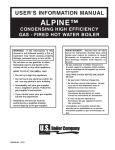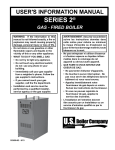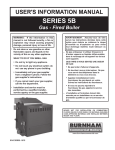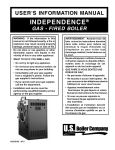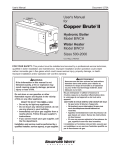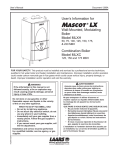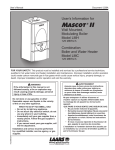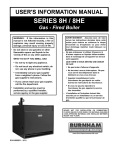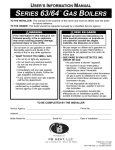Download Burnham Alpine User Manual 103449-02 (Alpine)
Transcript
U S E R ' S IN F OR M AT ION MAN U AL AL P I N E ™ C ON D E N S IN G H IGH E F F IC IE N C Y GAS - F IR E D H OT WAT E R B OIL E R WARNING If the information in this manual is not followed exactly, a fire or explosion may result causing property damage, personal injury or loss of life. Do not store or use gasoline or other - flammable vapors and liquids in the vicinity of this or any other appliance. - WHAT TO DO IF YOU SMELL GAS • Do not try to light any appliance. • Do not touch any electrical switch; do not use any phone in your building. • Immediately call your gas supplier from a neighbor's phone. Follow the gas supplier's instructions. • If you cannot reach your gas supplier, call the fire department. - Installation and service must be performed by a qualified installer, service agency or the gas supplier. 103449-02 - 4/14 AVERTISSEMENT Assurez-vous de bien suivre les instructions données dans cette notice pour réduire au minimum le risque d'incendie ou d'explosion ou pour éviter tout dommage matériel, toute blessure ou la mort. - Ne pas entreposer ni utiliser d'essence ni d'autres vapeurs ou liquides inflammables dans le voisinage de cet appareil ou de tout autre appareil. - QUE FAIRE SI VOUS SENTEZ UNE ODEUR DE GAZ: • Ne pas tenter d'allumer d'appareils. • Ne touchez à aucun interrupteur. Ne pas vous servir des téléphones dans le bâtiment où vous vous trouvez. • Appelez immédiatement votre fournisseur de gaz depuis un voisin. Suivez les instructions du fournisseur. • Si vous ne pouvez rejoindre le fournisseur de gaz, appelez le service des incendies. - L'installation et I'entretien doivent être assuréx par un installateur ou un service d'entretien qualifié ou par le fournisseur de gaz. The following terms are used throughout this manual to bring attention to the presence of hazards of various risk levels. DANGER Indicates an imminently hazardous situation which, if not avoided, will result in death, serious injury or substantial property damage. WARNING Indicates a potentially hazardous situation which, if not avoided, could result in death, serious injury or substantial property damage. CAUTION Indicates a potentially hazardous situation which, if not avoided, may result in moderate or minor injury or property damage. NOTICE Indicates special instructions on installation, operation, or maintenance which are important but not related to personal injury hazards. Basic Operation and Maintenance DANGER There are no user serviceable parts on this boiler. Attempts to service this boiler by someone other than a qualified gas service technician could void the warranty, cause property damage, personal injury or loss of life. CAUTION Should overheating occur or the gas supply fail to shut off, do not turn off or disconnect the electrical supply to the pump. Instead, shut off the gas supply at a location external to the appliance. En cas de surchauffe ou si I'admission de gaz ne peut étre coupée, ne pas couper ni débrancher l'alimentation électrique de la pompe. Fermer plutôt le robinet d'admission de gaz à l'extérieur de I'appareil. Do not use this boiler if any part has been under water. Immediately call a qualified service technician to inspect the boiler and to replace any part of the control system and any gas control which has been under water. CAUTION Like all central heating appliances, this boiler is equipped with safety devices, which could cause it to shutdown, requiring service to restore normal operation. Where such a shutdown could result in damage from low temperatures (such as frozen pipes), do not leave the heating system unattended during cold weather unless alarms or other safeguards are in place to prevent damage. 2 A.General 1. This manual covers the proper care and use of the Alpine™ Condensing High Efficiency Gas Fired Boiler. 2. Instructions to safely operate and shut down this boiler are shown in Figure 2 on page 5, as well as on a label affixed to the boiler. Control locations shown in Figure 1. 3. Alpine™ boilers use an electronic means built into the ignition system to extinguish the burner in the event that flames exit the combustion chamber. If the boiler fails to fire, call a qualified gas service technician to diagnose and correct the problem. 4. Alpine™ boilers are equipped with a safety feature which will shut down the burner in the event that there is a blockage in the vent system. In the event that the boiler fails to function, and the boiler is vented through an outside wall accessible from the ground, inspect the vent terminal on the outside wall for a blockage such as a bee’s nest or ice. If a blockage is found, the burner should ignite approximately 30 seconds after the blockage is removed. If no blockage is found, or if the terminal is inaccessible from the ground, the problem must be diagnosed and corrected by a qualified gas service technician. WARNING Asphyxiation Hazard. In the event that the ignition system on an Alpine boiler does not permit the boiler to fire, there is either a problem with the ignition system or a problem with the vent system. Call a qualified gas service technician to diagnose and correct the problem. A shutdown of the burner due to the pressure switch is an indication that there is a problem with the vent system, such as a blockage. The boiler pressure switch should only be reset after a qualified gas service technician has diagnosed and corrected the venting problem that caused the pressure switch to open. B.Maintenance 1. On a continuous basis: • Keep the area around the boiler free from combustible materials, gasoline, and other flammable vapors and liquids. • Keep the area around the combustion air inlet terminal and the area around the boiler free from contaminants, including all sources of hydrocarbons such as bleaches, fabric softeners, chemicals, sprays, cleaners, paint, paints, paint removers, refrigerants, and cat boxes. Traces of these chemicals can be drawing into the boiler, causing severe corrosion damage to the boiler and/or objectionable odors. • Keep the boiler room ventilation openings open and unobstructed. • Do not expose the boiler to large amounts of dust such as that generated by drywall construction or woodworking. 2. On a monthly basis: WARNING If any of the below listed conditions is found, follow instructions “TO TURN OFF GAS TO APPLIANCE” in Figure 2 and contact a qualified gas service technician to correct the problem before placing the boiler back in service. Failure to correct these conditions could result in property damage, personal injury or loss of life. • Inspect vent and combustion air intake terminals for obstruction or damage due to impact or excessive temperature. • Inspect vent and combustion air exterior wall penetrations to be sure they are weather tight. • Inspect the vent and combustion air intake system for obstructions, loose joints, condensate leakage, sags in horizontal runs of pipe, corrosion, or other deterioration. • Inspect flue temperature sensor cap at boiler rear for leakage and deterioration. • Inspect water and gas lines for leaks. • Remove boiler front door and inspect for carbon (soot) in or near the burner compartment, condensate drain leaks or blockage, or deterioration of the visible controls, wiring, or sheet metal components. • Inspect flame for true yellow tipping. Adjust thermostat to highest setting to turn on boiler and view flames through observation glass with front door removed. On high fire the flame should be stable and mostly blue. No true yellow tipping should be present, however intermittent flecks of yellow and orange in the flame caused by dust in air are normal. See Figure 3. If the burner flame looks satisfactory, adjust thermostat to normal setting and reinstall boiler front door. 3. On an annual basis: have a qualified gas service technician perform a more detailed inspection of the burner, heat exchanger, controls, and vent system and provide maintenance as specified in the Installation, Operating, and Service Instructions. 3 4 Figure 1: Control Locations (shown with optional concentric vent collar) Alpine™ Series Lighting and Operating Instructions Figure 2: Lighting Instructions 5 User Maintenance NOTICE The Alpine™ has a heat exchanger made from a special stainless steel alloy which can be severely damaged by frequent additions of water or by the addition of boiler water additives which are not designed for use with stainless steel boilers. If it is necessary to add water to the boiler, have a service technician check the system for leaks. Do not add any chemicals to the boiler not listed in Section X of the Alpine. Warranty is void if the service and maintenance procedure shown in Section XII of the Alpine instruction manual is not followed. Carbon (“soot”) in or near the burner compartment area is an indication of a potential carbon monoxide hazard. If carbon is found, immediately follow instructions "TO TURN OFF GAS TO APPLIANCE" in Figure 2 and contact a qualified gas service technician to correct the problem before placing the boiler back in service. Figure 3: Burner Flame 6 WARNING All Alpine™ Series Repair Parts may be obtained through your local U.S. Boiler Wholesale distributor. Should you require assistance in locating a U.S. Boiler distributor in your area, or have questions regarding the availability of U.S. Boiler products or repair parts, please contact U.S. Boiler Customer Service at (717) 481-8400 or Fax (717) 481-8408. Important Product Safety Information Refractory Ceramic Fiber Product Warning: The Repair Parts list designates parts that contain refractory ceramic fibers (RCF). RCF has been classified as a possible human carcinogen. When exposed to temperatures above 1805°F, such as during direct flame contact, RCF changes into crystalline silica, a known carcinogen. When disturbed as a result of servicing or repair, these substances become airborne and, if inhaled, may be hazardous to your health. AVOID Breathing Fiber Particulates and Dust Precautionary Measures: Do not remove or replace RCF parts or attempt any service or repair work involving RCF without wearing the following protective gear: 1. A National Institute for Occupational Safety and Health (NIOSH) approved respirator 2. Long sleeved, loose fitting clothing 3. Gloves 4. Eye Protection • • • • Take steps to assure adequate ventilation. Wash all exposed body areas gently with soap and water after contact. Wash work clothes separately from other laundry and rinse washing machine after use to avoid contaminating other clothes. Discard used RCF components by sealing in an airtight plastic bag. RCF and crystalline silica are not classified as hazardous wastes in the United States and Canada. First Aid Procedures: • • • • If contact with eyes: Flush with water for at least 15 minutes. Seek immediate medical attention if irritation persists. If contact with skin: Wash affected area gently with soap and water. Seek immediate medical attention if irritation persists. If breathing difficulty develops: Leave the area and move to a location with clean fresh air. Seek immediate medical attention if breathing difficulties persist. Ingestion: Do not induce vomiting. Drink plenty of water. Seek immediate medical attention. 7







